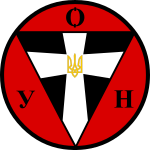우크라이나 민족주의자 조직
우크라이나 민족주의자 조직(우크라이나어: Організація українських націоналістів; OUN)은 우크라이나의 극우 민족주의 무장조직이었다. 1929년 빈에서 설립되어 동부 갈리치아(당시에는 폴란드 제2공화국령)에서 활동을 개시했다. 초창기의 OUN은 우크라이나 군사조직(UVO)을 비롯한 군소 우익 단체들, 드미트로 돈초프・예우헨 코노발레츠・미콜라 스치보르스키 등 우크라이나 민족주의 지식인들이 결합해 만든 연합체적 조직이었다.[1]


OUN의 이념은 이탈리아 파시즘과 유사했다.[2] OUN은 합법정당, 대학교 등 정치제도에 침투해서 활동하기를 도모했다.[1][3] OUN은 우크라이나의 독립이라는 목적을 이루기 위해 테러리즘을 전략으로 사용했고, 폴란드 제2공화국, 체코슬로바키아 제1공화국, 루마니아 왕국, 소비에트 연방을 그 공격대상인 외세의 적으로 삼았다.[1]
1940년, OUN은 두 갈래로 분열했다. 보다 온건한 고참 조직원들은 안드리이 아타나소비치 멜니크를 지지했고, 급진적인 청년 조직원들은 스테판 반데라를 지지했다. 멜니크파를 OUN-M, 반데라파를 OUN-B라고 한다. 1941년 추축국의 소련 침공이 개시되자(바르바로사 작전) OUN-B의 야로슬라프 스테츠코는 1941년 6월 30일 리비우에서 우크라이나의 독립을 선언했다. 그러나 리비우는 당시 나치 독일의 점령지였고,[3][4] 나치 관헌들은 OUN을 탄압했다. 1942년 10월 OUN-B는 우크라이나 분란군(UPA)을 창설했다. 1943년에서 1944년 사이에 UPA는 폴란드가 전후에 제2공화국 국경을 다시 주장하는 것을 막기 위해[5] 볼히니아와 동부 갈리치아의 폴란드인 학살을 일으켰다.[3] 역사학자들은 이 당시 볼히니아와 동갈리치아 지역에서 100,000 여명의 폴인이 학살당했다고 보고 있다.[6][7][8]
2차대전 종전 이후 UPA는 소련군 및 폴란드군과 싸웠다. 1947년, 폴란드 정부는 UPA의 지지기반을 없애기 위해 폴란드에 거주하는 우크라이나계 민간인 140,000 명을 강제이주시켰다(비스와 작전).[9] 이 과정에서 소련군이 죽이거나, 체포하거나, 강제이주시킨 우크라이나계 주민은 500,000 명을 넘는다. 그 피해자 상당수는 UPA 조직원과 그 가족 및 지지자들이었다.[3] 냉전이 시작되자 CIA를 비롯한 서방세계 첩보기관들은 은밀하게 OUN을 계속 지원했다.[10]
자유당, 우익 섹터, 우크라이나 국민회의, 우크라이나 민족주의자 회의 등 현대 우크라이나의 극우 정치조직들이 OUN의 정치적 유산의 계승자를 자처하고 있다.[3][11] OUN의 역사적 평가는 엇갈린다. OUN의 계승자를 자처하는 단체들은 OUN의 파시즘적 성향과 나치 부역 사실을 부인하고자 한다.
같이 보기
편집각주
편집- ↑ 가 나 다 Shekhovtsov, Anton (March 2011). “The Creeping Resurgence of the Ukrainian Radical Right? The Case of the Freedom Party”. Europe-Asia Studies 63 (2): 207–210. doi:10.1080/09668136.2011.547696. S2CID 155079439.
- ↑ Marples, David (2013). 〈The OUN, 1929–43〉. 《Heroes and Villians》. Central European University Press. 79–123쪽. ISBN 9789637326981.
- ↑ 가 나 다 라 마 Rudling, Per Anders (2013). 〈The Return of the Ukrainian Far Right: The Case of VO Svoboda〉 (PDF). Wodak and Richardson. 《Analysing Fascist Discourse: European Fascism in Talk and Text》. New York: Routledge. 229–235쪽.
- ↑ “Державний архів Львівської області”. 2017년 1월 5일에 원본 문서에서 보존된 문서. 2016년 12월 19일에 확인함.
- ↑ Timothy Snyder. (2004) The Reconstruction of Nations. New Haven: Yale University Press: pg. 168
- ↑ Motyka, Grzegorz (2016). 《Wołyń'43 Ludobójcza czystka – fakty, analogie, polityka historyczna》. Cracow: Wydawnictwo Literackie. 83쪽. ISBN 978-83-08-06207-4.
- ↑ Massacre, Volhynia. “The Effects of the Volhynian Massacres”. 《Volhynia Massacre》 (영어). 2018년 6월 30일에 확인함.
- ↑ Pertti, Ahonen (2008). 《Peoples on the Move: Population Transfers and Ethnic Cleansing Policies During World War II and Its Aftermath》. Bloomsbury Academic. 99쪽.
- ↑ "Poland's president expresses regret over 1947 Akcja Wisla Archived 2020년 8월 6일 - 웨이백 머신", The Ukrainian Weekly
- ↑ Rudling, Per Anders (2013). “The Return of the Ukrainian Far Right: The Case of VO Svoboda”. Wodak and Richardson. Analysing Fascist Discourse: European Fascism in Talk and Text. New York: Routledge. 229–35쪽.
During the Cold War, US, West German, and British intelligence utilized various OUN wings in ideological warfare and covert actions against the Soviet Union (Breitman and Goda, 2010: 73– 98; Breitman, Goda, Naftali and Wolfe, 2005). Funded by the CIA, which sponsored Lebed's immigration to the United States and protected him from prosecution for war crimes, OUN(z) activists formed the core of the Proloh Research and Publishing Association, a pro-nationalist semi academic publisher.
- ↑ Umland, Andreas; Anton Shekhovstsov (2013). “Ultraright Party Politics in Post-Soviet Ukraine and the Puzzle of the Electoral Marginalism of Ukraine Ultranationalists in 1994–2009.”. 《Russian Politics and Law》 51 (5): 33–58. doi:10.2753/rup1061-1940510502. S2CID 144502924.
In 1990, one of the best known nationalist parties—the Ukrainian National Assembly (UNA), headed by Dmytro Korchyns'kyi—was established in Lviv ... . In Ukraine itself, the UNA-UNSD became a media phenomenon, not least thanks to its deliberate provocation aimed at left-wing and pro-Russian forces and its frequent clashes with the police. But the UNA had little political success ... . The second best-known ultraright party to emerge at the beginning of the 1990s was the Congress of Ukrainian Nationalists (CUN)—a direct heir of the Organization of Ukrainian Nationalists (Bandera) (OUN-B), which Stepan Bandera headed in 1940 after a split in the original OUN. The continuity between the OUN-B and the CUN was ensured by the return from emigration of Iaroslava Stets'ko, a former member of the OUN-B and the widow of Iaroslav Stets'ko, one of the leaders of the OUN-B and the Ukrainian Insurgent Army